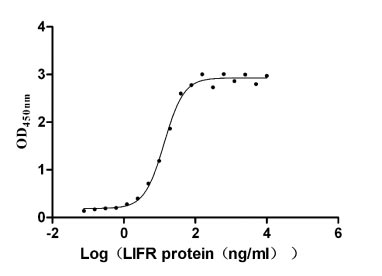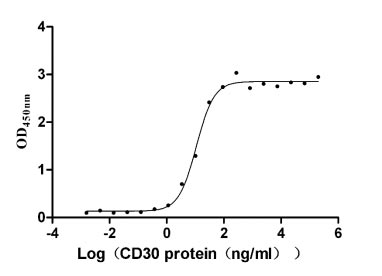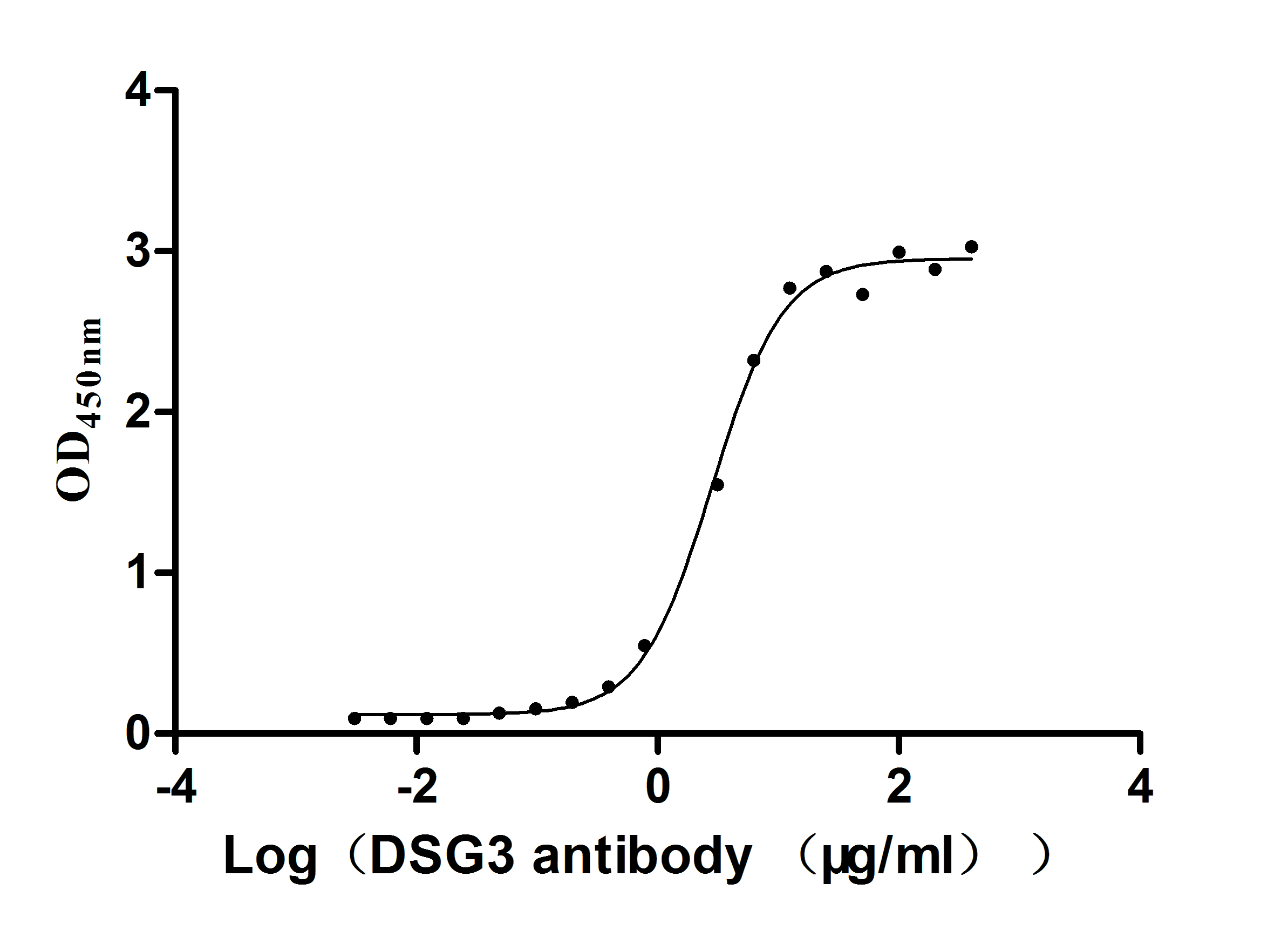Recombinant Human Aryl-hydrocarbon-interacting protein-like 1 (AIPL1)
-
中文名称:Recombinant Human Aryl-hydrocarbon-interacting protein-like 1(AIPL1),Yeast
-
货号:CSB-YP882159HU
-
规格:
-
来源:Yeast
-
其他:
-
中文名称:Recombinant Human Aryl-hydrocarbon-interacting protein-like 1(AIPL1),Yeast
-
货号:CSB-EP882159HU-B
-
规格:
-
来源:E.coli
-
共轭:Avi-tag Biotinylated
E. coli biotin ligase (BirA) is highly specific in covalently attaching biotin to the 15 amino acid AviTag peptide. This recombinant protein was biotinylated in vivo by AviTag-BirA technology, which method is BriA catalyzes amide linkage between the biotin and the specific lysine of the AviTag.
-
其他:
-
中文名称:Recombinant Human Aryl-hydrocarbon-interacting protein-like 1(AIPL1),Yeast
-
货号:CSB-BP882159HU
-
规格:
-
来源:Baculovirus
-
其他:
-
中文名称:Recombinant Human Aryl-hydrocarbon-interacting protein-like 1(AIPL1),Yeast
-
货号:CSB-MP882159HU
-
规格:
-
来源:Mammalian cell
-
其他:
产品详情
-
纯度:>85% (SDS-PAGE)
-
基因名:AIPL1
-
Uniprot No.:
-
别名:A930007I01Rik; Aipl1; AIPL1_HUMAN; AIPL2; Aryl hydrocarbon interacting protein like 1; Aryl hydrocarbon receptor interacting protein like 1; Aryl-hydrocarbon-interacting protein-like 1; LCA4; MGC25485; OTTHUMP00000128207; OTTMUSP00000006382; RP23-401C17.1
-
种属:Homo sapiens (Human)
-
蛋白长度:full length protein
-
表达区域:1-384
-
氨基酸序列MDAALLLNVE GVKKTILHGG TGELPNFITG SRVIFHFRTM KCDEERTVID DSRQVGQPMH IIIGNMFKLE VWEILLTSMR VHEVAEFWCD TIHTGVYPIL SRSLRQMAQG KDPTEWHVHT CGLANMFAYH TLGYEDLDEL QKEPQPLVFV IELLQVDAPS DYQRETWNLS NHEKMKAVPV LHGEGNRLFK LGRYEEASSK YQEAIICLRN LQTKEKPWEV QWLKLEKMIN TLILNYCQCL LKKEEYYEVL EHTSDILRHH PGIVKAYYVR ARAHAEVWNE AEAKADLQKV LELEPSMQKA VRRELRLLEN RMAEKQEEER LRCRNMLSQG ATQPPAEPPT EPPAQSSTEP PAEPPTAPSA ELSAGPPAEP ATEPPPSPGH SLQH
-
蛋白标签:Tag type will be determined during the manufacturing process.
The tag type will be determined during production process. If you have specified tag type, please tell us and we will develop the specified tag preferentially. -
产品提供形式:Lyophilized powder
Note: We will preferentially ship the format that we have in stock, however, if you have any special requirement for the format, please remark your requirement when placing the order, we will prepare according to your demand. -
复溶:We recommend that this vial be briefly centrifuged prior to opening to bring the contents to the bottom. Please reconstitute protein in deionized sterile water to a concentration of 0.1-1.0 mg/mL.We recommend to add 5-50% of glycerol (final concentration) and aliquot for long-term storage at -20℃/-80℃. Our default final concentration of glycerol is 50%. Customers could use it as reference.
-
储存条件:Store at -20°C/-80°C upon receipt, aliquoting is necessary for mutiple use. Avoid repeated freeze-thaw cycles.
-
保质期:The shelf life is related to many factors, storage state, buffer ingredients, storage temperature and the stability of the protein itself.
Generally, the shelf life of liquid form is 6 months at -20°C/-80°C. The shelf life of lyophilized form is 12 months at -20°C/-80°C. -
货期:Delivery time may differ from different purchasing way or location, please kindly consult your local distributors for specific delivery time.Note: All of our proteins are default shipped with normal blue ice packs, if you request to ship with dry ice, please communicate with us in advance and extra fees will be charged.
-
注意事项:Repeated freezing and thawing is not recommended. Store working aliquots at 4°C for up to one week.
-
Datasheet :Please contact us to get it.
相关产品
靶点详情
-
功能:May be important in protein trafficking and/or protein folding and stabilization.
-
基因功能参考文献:
- This review summarizes important recent advances in understanding the mechanisms underlying normal function of AIPL1 and the protein perturbations caused by pathogenic mutations PMID: 28939106
- findings offer critical insights into the mechanisms that underlie AIPL1 function in health and disease, and highlight the structural and functional diversity of the FKBPs PMID: 28739921
- s characterized the functional deficits of AIPL1 variations, some of which induce aberrant pre-mRNA AIPL1 splicing leading to the production of alternative AIPL1 isoforms and investigated the ability of the AIPL1 variants to mediate an interaction with HSP90 and modulate the rod cGMP PDE6 stability and activity. PMID: 28973376
- Findings suggest that AIPL1 function in retinal photoreceptor cells is not related to the role of EB proteins in microtubule dynamics or primary ciliogenesis, but their association may be related to a specific role in the retinal photoreceptors. PMID: 25799540
- The s established a transgenic mouse model for cone-rod dystrophy carrying human AIPL1 gene with deletion in the C-terminal proline-rich region. PMID: 25274777
- Gene therapy based approach may be worthy of consideration in a small group of selected patients with preserved outer retinal structure in AIPL1 Leber's congenital amaurosis. PMID: 25596619
- Mutations in the AIPL1 and RDH12 genes associated with leber congenital amaurosis in two Turkish families. PMID: 25148430
- In this chapter, using results obtained from multiple lines of animal models, we discuss the role for AIPL1 in photoreceptors. PMID: 24664679
- The unique proline-rich domain of AIPL1 is important for its chaperone function as its truncation severely affects the ability of AIPL1 to bind non-native proteins. PMID: 23418749
- Patients with mutations in AIPL1 may present with Leber congenital amaurosis and residual ERGs (electroretinography) characterized by slow insensitive scotopic responses. PMID: 21900377
- AIPL1-Leber congenital amaurosis (LCA), unlike some other forms of LCA with equally severe visual disturbance, shows profound loss of foveal as well as extrafoveal photoreceptors. PMID: 20702822
- AIPL1 is needed for the proper functioning and survival of cone photoreceptors. PMID: 20042464
- Variations of macular microstructures were observed among LCA (Leber congenital amaurosis) patients with different genotypes. PMID: 19959640
- Phenotype-genotype correlations of AIPL1-associated Leber's congenital amaurosis (LCA) PMID: 11548141
- AIPL1 performs a function essential to the maintenance of rod photoreceptor function PMID: 11929855
- The inherited blindness associated protein AIPL1 interacts with the cell cycle regulator protein NUB1 in the retina. PMID: 12374762
- Interacts with and aids in processing of farnesylated proteins in the retina. PMID: 14555765
- interaction between NUB1 and AIPL1 is affected in patients with Leber congenital amaurosis PMID: 15081406
- Plays role in cytosolic stability and/or nuclear transport of NUB1 during regulation of cell cyle during photoreceptor development. PMID: 15180275
- The phenotype of LCA (Leber congenital amaurosis) in patients with AIPL1 mutations is relatively severe, with a maculopathy in most patients and keratoconus and cataract in a large subset. PMID: 15249368
- Data show that aryl hydrocarbon receptor-interacting protein-like 1 (AIPL1) can modulate protein translocation and act in a chaperone-like manner and suggest that AIPL1 is an important modulator of NEDD8 ultimate buster protein 1 (NUB1) cellular function. PMID: 15347646
- aryl hydrocarbon interacting protein-like 1 (AIPL1) mutations may have a role in inherited retinal dystrophies PMID: 15469903
- AIPL1 may cooperate with both Hsp70 and Hsp90 within retina-specific chaperone heterocomplex, and specialized role of AIPL1 in photoreceptors may therefore be facilitated by these molecular chaperones. PMID: 18408180
显示更多
收起更多
-
相关疾病:Leber congenital amaurosis 4 (LCA4)
-
亚细胞定位:Cytoplasm. Nucleus.
-
组织特异性:Highly expressed in retina. Specifically localized to the developing photoreceptor layer and within the photoreceptors of the adult retina.
-
数据库链接:
HGNC: 359
OMIM: 604392
KEGG: hsa:23746
STRING: 9606.ENSP00000370521
UniGene: Hs.279887
Most popular with customers
-
Recombinant Human Leukemia inhibitory factor receptor (LIFR), partial (Active)
Express system: Mammalian cell
Species: Homo sapiens (Human)
-
Recombinant Human Tumor necrosis factor ligand superfamily member 8 (TNFSF8), partial (Active)
Express system: Mammalian cell
Species: Homo sapiens (Human)
-
Recombinant Mouse Desmoglein-3 (Dsg3), partial (Active)
Express system: Mammalian cell
Species: Mus musculus (Mouse)
-
Recombinant Rabbit Tissue factor pathway inhibitor (TFPI) (Active)
Express system: Mammalian cell
Species: Oryctolagus cuniculus (Rabbit)
-
Recombinant Human C-X-C chemokine receptor type 4 (CXCR4)-VLPs (Active)
Express system: Mammalian cell
Species: Homo sapiens (Human)
-
Recombinant Human Glucagon-like peptide 1 receptor (GLP1R), partial (Active)
Express system: Mammalian cell
Species: Homo sapiens (Human)
-
Recombinant Human Desmoglein-3 (DSG3), partial (Active)
Express system: Baculovirus
Species: Homo sapiens (Human)
-
Recombinant Human C-C chemokine receptor type 6(CCR6)-VLPs (Active)
Express system: Mammalian cell
Species: Homo sapiens (Human)






-AC1.jpg)













